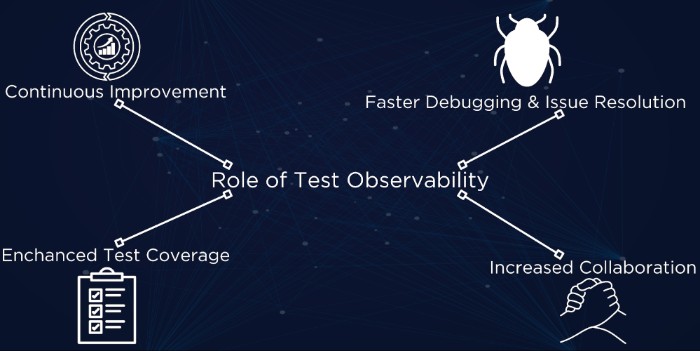What is test observability, and how does it support debugging?
In modern software development, achieving high-quality releases requires more than just running tests-it demands visibility into how those tests perform and why they might fail. Test observability provides this clarity, offering insights into every aspect of the testing process. By understanding test behavior and outcomes in detail, teams can debug faster and ensure reliability.
Test observability is deeply tied to observability in software engineering, a broader practice that focuses on understanding system performance through metrics, logs, and traces. This concept now extends into the testing domain, where observability-driven development is reshaping how teams identify and resolve issues. This article explores test observability, its importance, and how it supports effective debugging.
What is Test Observability?
Test observability refers to the practice of gaining comprehensive visibility into the testing process. It focuses on collecting and analyzing metrics, logs, and traces from tests to understand their performance, coverage, and outcomes. Unlike traditional testing, which often delivers binary results (i.e., pass/fail), test observability delves deeper, answering these critical questions:
- Why did a test fail?
- Was the failure related to code, infrastructure, or environment?
- How can similar issues be avoided in the future?
By connecting testing activities with underlying system behaviors, test observability bridges the gap between quality assurance (QA) and system reliability. For instance, in a distributed system, observability can highlight whether a failed test stems from a microservice error, a network delay, or misconfigured infrastructure.
Why Test Observability Matters
Traditional testing methods struggle to keep up with the growing complexity of modern systems, particularly those using microservices, serverless architectures, or containerized deployments. A lack of visibility often means teams spend significant time troubleshooting test failures without clear insight into their root causes.
Test observability addresses these gaps by:
- Providing real-time insights: Teams gain immediate visibility into test behaviors and system responses, making it easier to spot anomalies.
- Connecting testing and system health: Observability links test results to the performance and state of the underlying system, providing context for failures.
- Enhancing decision-making: With actionable data, teams can prioritize fixes and improvements based on impact and urgency.
For instance, if a test suite for an e-commerce platform reveals performance degradation during a sale event simulation, observability-driven development can pinpoint whether the issue lies in a database bottleneck or a specific API endpoint. This reflects the principles of observability-driven development (ODD), where test insights guide system improvement.
Supporting Debugging Through Test Observability
Debugging is one of the most time-consuming aspects of software development, and test observability can significantly reduce this burden. Here’s how:
- Root cause identification: Observability tools correlate test failures with system logs and metrics, making it easier to trace the root cause of issues. For example, if a performance test fails, observability can highlight whether the issue lies in a specific microservice or an overloaded database query.
- Flaky test detection: Observability helps identify flaky tests-those that fail intermittently due to environmental factors rather than code defects. By analyzing patterns over multiple test runs, teams can isolate and address such tests effectively.
- Reduced debugging time: Instead of manually combing through logs, developers can rely on observability dashboards to visualize failures and anomalies, drastically reducing debugging time.
For instance, imagine a test suite failing during a CI/CD pipeline run. Test observability could show that the failure correlates with a spike in API response times, guiding developers directly to the problem.
Key Benefits of Test Observability
The adoption of test observability provides several advantages:
- Faster debugging cycles: Teams can quickly pinpoint and resolve issues, minimizing delays.
- Improved collaboration: QA, DevOps, and developers can share unified insights, fostering better teamwork.
- Enhanced software quality: By identifying potential issues early, teams can deliver more reliable software.
- Proactive problem detection: Observability often uncovers underlying system issues that might otherwise go unnoticed during testing.
Challenges in Implementing Test Observability
While the benefits are compelling, achieving test observability can be challenging:
- Cost and complexity: Implementing observability tools can require significant investment in both software and expertise.
- Data overload: Managing and analyzing large volumes of metrics, logs, and traces can be overwhelming without proper tools.
- Cultural resistance: Teams accustomed to traditional testing may resist adopting new practices.
Overcoming these challenges requires a clear strategy, robust tooling, and stakeholder buy-in.
Best Practices for Achieving Test Observability
To make the most of test observability, consider these best practices:
- Use advanced tools: Invest in platforms that simplify analysis and provide detailed logs, metrics, and visual dashboards.
- Integrate observability into CI/CD pipelines: Continuous feedback from observability tools ensures faster resolution of issues.
- Monitor long-term trends: Track test performance over time to identify recurring patterns and optimize processes.
- Automate where possible: Use automation to correlate logs and metrics, reducing manual effort.
These practices can help teams fully leverage observability for effective testing and debugging.


